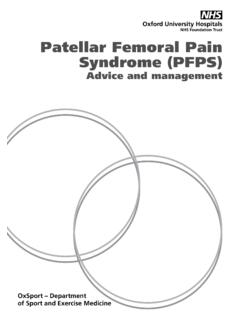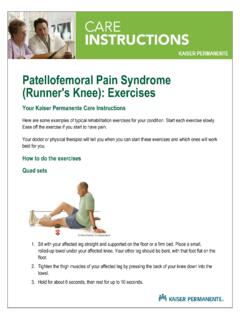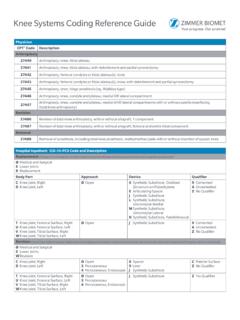Transcription of Post-Operative Care for Orthopedic Surgery Femoral Head ...
1 Post-Operative Care for Orthopedic Surgery Femoral Head and Neck Ostectomy (FHO) John F. Wilson , Diplomate ABVP Kelly Hatton, CCRA Emily Alfonsi LVT, CCRA 586-752-6217 - Hospital 586-322-4454 Rehab Department This document contains information about what to expect after your dog has had FHO Surgery . We hope this can better prepare you for your dog s recovery and answer your questions. This information is a general guideline as to what is normal after Surgery . Please understand that your dog may heal faster or slower than what is indicated. Contact your veterinarian if your dog experiences either decrease in function or significant increase in pain during the recovery phase.
2 An FHO removes the portion of the femur that normally forms the hip joint, promoting the formation of a false joint over time as scar tissue develops. Removing the joint will eliminate the source of your dog s pain, and with careful surgical technique and proper post-op therapy, the average dog will regain 80% of his/her normal function. Early physical rehabilitation after FHO Surgery is important because inactivity can lead to increased scar tissue and decreased range of motion in the joint. The follow-up care after an FHO procedure is unique among Orthopedic procedures as a false joint needs to be formed. Restricted activity is not as important as with a fracture or joint repair.
3 Formal rehab is very helpful and advised for all patients. Phase I (0-10 days after Surgery ) First 24-48 hours o It is normal for your dog to experience discomfort and refuse to urinate or have bowel movements as often as they normally do. o Walking on 3 legs and/or walking with the surgical leg slightly touching the ground is normal at this point. o Assistance with a sling may be necessary at this time. o An increase in bruising and swelling may occur. o Please check the incision daily for excessive swelling, discharge, or redness. Make sure your dog is not licking or biting the incision. o Ice application An ice pack can be applied to your dog s hip every 4-6 hours for 15-20 minutes to help control pain and inflammation.
4 Using a barrier ( thin towel) is necessary between the ice pack and skin if using a commercial gel pack. Activity (Days 1 and 2) o Activity should consist of short leashed walks for elimination only. o When unsupervised, confinement is necessary either in a cage or small area. Your dog is allowed to slowly walk around the house with direct supervision as long as it is not constant. o No running, jumping, or playing at this time. Stairs and slick floors ( tile and wood) are discouraged, however, if these areas cannot be avoided please assist your dog to prevent falling. After 2 days o Short 3-5 minute leashed walks can be started every 3-4 hours.
5 Walk very SLOWLY to encourage usage of the leg. Increase the walks by 1-2 minutes each week as tolerated. o Passive range of motion can be started. Very slowly extend your dog s hip by swinging his/her leg backwards as far back as tolerated. Hold for 15 seconds and repeat 4 times. RECHECK WITH YOUR SURGEON 12-14 DAYS AFTER Surgery A PHYSICAL REHABILITATION PROGRAM CAN BE STARTED 7-10 DAYS AFTER Surgery PLEASE CONTACT: KELLY HATTON OR EMILY ALFONSI WITH NORTH MACOMB CANINE REHABILITATION AND CONDITIONING TO SCHEDULE AN APPOINTMENT (586) 322-4454 Phase II (10-30 days after Surgery ) Activity o Continue to increase the intensity of the walks by 1-2 minutes each week.
6 O Start walking on inclines. o Stairs can be done as tolerated. Appearance o The surgical leg is used 80-100% of the time when walking at a slow pace. o Most dogs still shift their weight off the surgical leg when standing. o By 2-3 weeks after Surgery , all dogs should be using the surgical leg when walking. A rehabilitation program should be initiated at this time if your dog is not using the leg very well. Please contact the rehabilitation department for further assistance. RECHECK WITH YOUR SURGEON 5-6 weeks post Surgery Phase III (30-60 days after Surgery ) Activity o Supervised off-leash activity can be done as tolerated.
7 O Rough play should still be avoided at this time. o Ball retrieval should be avoided if your dog pounces on the ball or turns quickly. o Light jogs can be initiated as long as leg is being used. o Continue to increase the intensity of the walks. Appearance o A slight limp will still be noticeable, and the limb might still be lifted when transitioning to a faster speed. o At a standing position, limb should be planted on the ground but still may be in a partially weight-bearing position. Phase IV (Greater than 60 days after Surgery ) Activity o Jumping on and off of furniture, cars, etc is usually acceptable after 2 months.
8 O Restrictions are based on dog s comfort level. o Normal activity can be resumed. o If your dog is a performance and/or working dog that requires high intensity exercise, please discuss this level of activity with your surgeon or rehab specialist before resuming.








